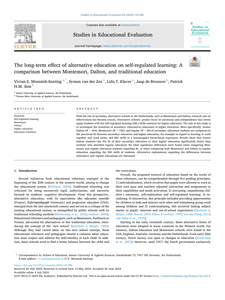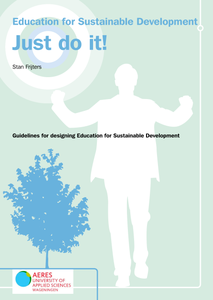Morssink-Santing, V. E., van der Zee, S., Klaver, L. T., de Brouwer, J., andamp; Sins, P. H. (2024). The long-term effect of alternative education on self-regulated learning: A comparison between Montessori, Dalton, and traditional education. Studies in Educational Evaluation, 83, 101380. https://doi.org/10.1016/j.stueduc.2024.101380
MULTIFILE

This dissertation aims to strengthen socioscientific issues (SSI) education by focusing on the resources available to students. SSI education is a type of science and citizenship education that supports students’ informed and critical engagement with social issues that have scientific or technological dimensions. This dissertation explores students’ SSI-related resources relevant to their engagement with SSI, such as their attitudes and social resources. The dissertation consists of four papers. The first is a position paper that introduces the concept of socioscientific capital and argues why it is important to pay attention to students’ resources in SSI-based teaching. The other three papers involve empirical, quantitative studies. Two questionnaires were developed that were used to investigate student differences regarding engagement with SSI: the Pupils’ Attitudes towards Socioscientific Issues (PASSI) questionnaire and the Use of Sources of Knowledge (USK) questionnaire. The final study is an exploration of the effects of SSI-based teaching on students’ attitudes toward SSI, considering socioscientific capital.
MULTIFILE
Innovation is crucial for higher education to ensure high-quality curricula that address the changing needs of students, labor markets, and society as a whole. Substantial amounts of resources and enthusiasm are devoted to innovations, but often they do not yield the desired changes. This may be due to unworkable goals, too much complexity, and a lack of resources to institutionalize the innovation. In many cases, innovations end up being less sustainable than expected or hoped for. In the long term, the disappointing revenues of innovations hamper the ability of higher education to remain future proof. Against the background of this need to increase the success of educational innovations, our colleague Klaartje van Genugten has explored the literature on innovations to reveal mechanisms that contribute to the sustainability of innovations. Her findings are synthesized in this report. They are particularly meaningful for directors of education programs, curriculum committees, educational consultants, and policy makers, who are generally in charge of defining the scope and set up of innovations. Her report offers a comprehensive view and provides food for thought on how we can strive for future-proof and sustainable innovations. I therefore recommend reading this report.
DOCUMENT

Author Supplied: In the last decades, architecture has emerged as a discipline in the domain of Information Technology (IT). A well-accepted definition of architecture is from ISO/IEC 42010: "The fundamental organization of a system, embodied in its components, their relationships to each other and the environment, and the principles governing its design and evolution." Currently, many levels and types of architecture in the domain of IT have been defined. We have scoped our work to two types of architecture: enterprise architecture and software architecture. IT architecture work is demanding and challenging and includes, inter alia, identifying architectural significant requirements (functional and non-functional), designing and selecting solutions for these requirements, and ensuring that the solutions are implemented according to the architectural design. To reflect on the quality of architecture work, we have taken ISO/IEC 8402 as a starting point. It defines quality as "the totality of characteristics of an entity that bear on its ability to satisfy stated requirements". We consider architecture work to be of high quality, when it is effective; when it answers stated requirements. Although IT Architecture has been introduced in many organizations, the elaboration does not always proceed without problems. In the domain of enterprise architecture, most practices are still in the early stages of maturity with, for example, low scores on the focus areas ‘Development of architecture’ and ‘Monitoring’ (of the implementation activities). In the domain of software architecture, problems of the same kind are observed. For instance, architecture designs are frequently poor and incomplete, while architecture compliance checking is performed in practice on a limited scale only. With our work, we intend to contribute to the advancement of architecture in the domain of IT and the effectiveness of architecture work by means of the development and improvement of supporting instruments and tools. In line with this intention, the main research question of this thesis is: How can the effectiveness of IT architecture work be evaluated and improved?
DOCUMENT

Sustainable development has become a crucial part of our modern society and our education. Sustainability is a complex concept. After all, what is considered sustainable to us now may not necessarily be so in the future. We need to continually review our judgments with regards to sustainability. Education for Sustainable Development is about knowledge, attitude, behaviour and values, in which the relationship between a social, an ecological and an economic perspective is always factored in. But what does this education look like? Education for Sustainable Development. Just do it! was the motto for the practice-oriented study by Aeres University of Applied Sciences Wageningen, involving four schools and two universities. This publication describes the theoretical principles of Education for Sustainable Development and the design criteria as were used in this practice-oriented study. This publication describes the theoretical principles of Education for Sustainable Development and the design criteria as were used in this practice-oriented study. These design criteria can help us develop and implement Education for Sustainable Development.
DOCUMENT

In deze aflevering vertellen Eelco Braad en Marieke Veltman over hun onderzoek.
LINK
Author supplied: Within the Netherlands the interest for sustainability is slowly growing. However, most organizations are still lagging behind in implementing sustainability as part of their strategy and in developing performance indicators to track their progress; not only in profit organizations but in higher education as well, even though sustainability has been on the agenda of the higher educational sector since the 1992 Earth Summit in Rio, progress is slow. Currently most initiatives in higher education in the Netherlands have been made in the greening of IT (e.g. more energy efficient hardware) and in implementing sustainability as a competence in curricula. However if we look at the operations (the day to day processes and activities) of Dutch institutions for higher education we just see minor advances. In order to determine what the best practices are in implementing sustainable processes, We have done research in the Netherlands and based on the results we have developed a framework for the smart campus of tomorrow. The research approach consisted of a literature study, interviews with experts on sustainability (both in higher education and in other sectors), and in an expert workshop. Based on our research we propose the concept of a Smart Green Campus that integrates new models of learning, smart sharing of resources and the use of buildings and transport (in relation to different forms of education and energy efficiency). Flipping‐the‐classroom, blended learning, e‐learning and web lectures are part of the new models of learning that should enable a more time and place independent form of education. With regard to smart sharing of resources we have found best practices on sharing IT‐storage capacity among universities, making educational resources freely available, sharing of information on classroom availability and possibilities of traveling together. A Smart Green Campus is (or at least is trying to be) energy neutral and therefore has an energy building management system that continuously monitors the energy performance of buildings on the campus. And the design of the interior of the buildings is better suited to the new forms of education and learning described above. The integrated concept of Smart Green Campus enables less travel to and from the campus. This is important as in the Netherlands about 60% of the CO2 footprint of a higher educational institute is related to mobility. Furthermore we advise that the campus is in itself an object for study by students and researchers and sustainability should be made an integral part of the attitude of all stakeholders related to the Smart Green Campus. The Smart Green Campus concept provides a blueprint that Dutch institutions in higher education can use in developing their own sustainability strategy. Best practices are shared and can be implemented across different institutions thereby realizing not only a more sustainable environment but also changing the attitude that students (the professionals of tomorrow) and staff have towards sustainability.
DOCUMENT

Over the past decade, the maker movement and in its slipstream maker education have attained worldwide popularity among educators, politicians, and the media. Makers’ enthusiasm for creative design and construction, using old and new tools has proven contagious, and is worth exploration and critical reflection by the community of engineering and technology education (ETE). This chapter describes what has been said about “making” by philosophers and educators; what maker education is, and what is new and not so new about it; why it has gained momentum; what the evidence is about its effectiveness and its possible weaknesses; and how mainstream technology education may benefit from maker education. This chapter concludes with ideas for a research agenda.
LINK
This is the editorial paper for the virtual special issue “Using Q methodology in higher education: Opportunities and challenges”, consisting of nine original research studies from different international contexts. In addition to presenting novel findings, contributors were invited to discuss the following two questions at the center of the special issue call: In what sense has Q methodology served as a fitting approach to investigate subjectivity in higher education? What methodological opportunities and challenges arise with Q methodology in higher education settings? This editorial provides an overview and discussion of the various justifications mentioned for Q methodology. Furthermore, it collates the opportunities and challenges contributors discuss in relation to their studies using this almost 90-year-old methodological approach. The editorial paper concludes with recommendations for future Q methodological studies in higher education and beyond.
MULTIFILE

Currently, various higher education (HE) institutes develop flexible curricula for various reasons, including promoting accessibility of HE, the societal need for more self-regulated professionals who engage in life-long learning, and the desire to increase motivation of students. Increasing flexibility in curricula allows students to choose for example what they learn, when they learn, how they learn, where they learn, and/or with whom. However, HE institutes raise the question of what preferences and needs different stakeholders have with regard to flexibility, so that suitable choices can be made in the design of policies, curricula, and student support programs. In this workshop, we focus on student preferences and share recent insights from research on HE students' preferences regarding flexible education. Moreover, we use participants’ expertise to identify new (research) questions to further explore what students’ needs imply for several domains, namely curriculum-design, student support that is provided by educators/staff, policy, management, and the professional field. Firstly, a conceptual framework on flexible education and student’s preferences will be presented. Secondly, participants reflect in groups on student personas. Then, discussion groups have a Delphi-based discussion to collect new ideas for research. Finally, participants share the outcomes on a ‘willing wall’ and a ‘wailing wall’.
MULTIFILE
